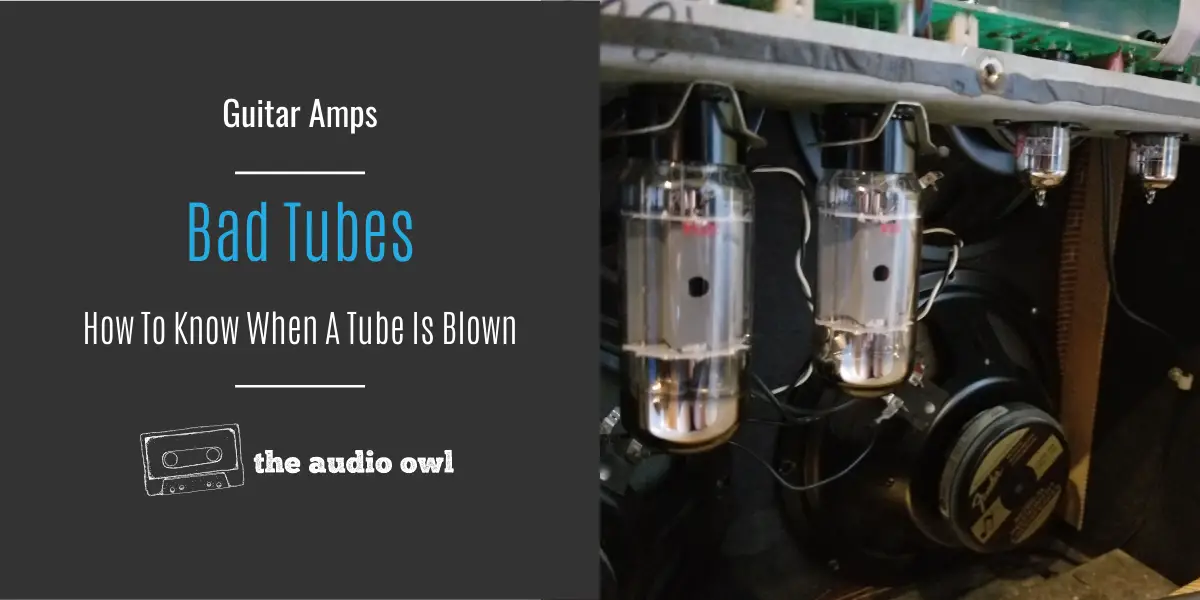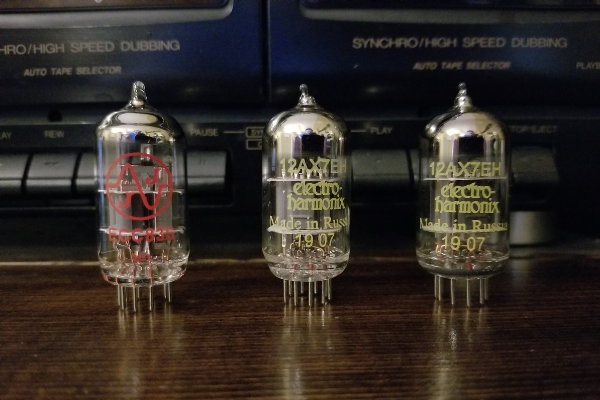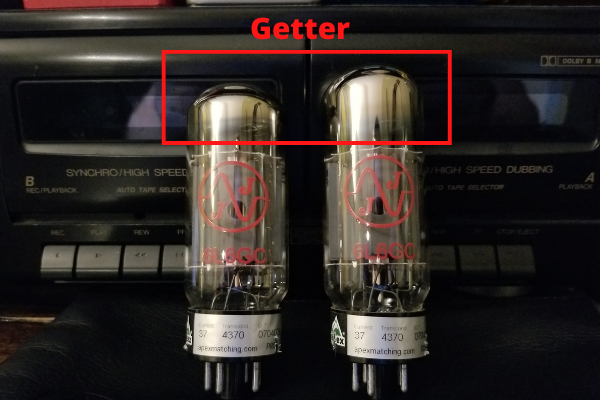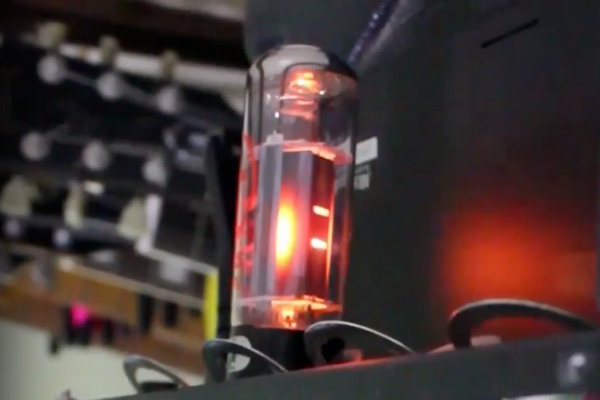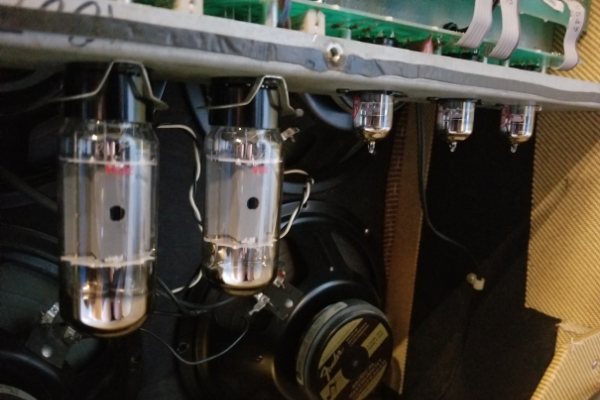I recently had an experience with a bad tube in my guitar amp. It was definitely not fun!
I had just come back from vacation, excited to crank up the volume and do some jamming. The only problem was, the amp was not working correctly. The sound was “there” but was very weak sounding as if not enough power was getting through.
After pulling the cover from the back of the amp, I took a look at the tubes. All 3 preamp tubes looked fine, with no obvious visible signs of failure. The power amp tubes looked fine as well.
Still, the amp wouldn’t work properly so I had to take it in for repairs. Turns out it was one of the tubes. If I knew what I was looking for, I could have saved myself the costly repair fees.
That is why I wanted to put this post together, to help our readers diagnose a blown tube when they have one!
First Signs Of A Bad Tube
Ok, so your amp is not working correctly or sounds weird. How do you know if it’s the tubes?
Well, there are a few telltale signs that can point you in the direction of a blown tube.
Let’s take a look at them below…
The Amps Tone Sounds Weak
In this case, the amp will produce some volume and the tone may sound distorted.
You’ll find that the volume you do get out of the amp is really low compared to normal. You can crank the amp up to 10 and the amp will still not sound loud enough.
The sound will also sound weak like there is just not enough power driving the signal. When playing normally, the sound will be quiet and sputtery. But, when you really hit the strings, you can hear the amp break up a little bit more. Not in a good way either.
This can point to either a blown preamp or a blown power amp tube.
Tubes begin to weaken over time. Especially power tubes as they are run at much higher voltages than the preamp tubes. As the tubes weaken, they start to lose their frequency response. This can be perceived as a loss of volume.
Noise And Microphonics
Most tubes will make some sort of noise when tapped or knocked around. But a microphonic tube can amplify those taps and even create hiss and pops.
Sometimes, a ringing in the amp will occur when a tube goes microphonic. As you can hear in the video below, this is a less than ideal situation. The clear solution is to change the tube.
As you can guess by the name, a microphonic tube will amplify sounds around it such as taps, bumps, and walking near the amp.
Bad tubes can also start to hiss or create weird sputtering pops. These will sound like a microphone is placed up close to the tube as it is heating up. As it heats and expands it starts to creak. Those creaks are then introduced into the audio signal and played out through the speaker.
What Does A Bad Tube Look Like?
The easiest way is to check them with a multimeter or a tube tester. But those options can be expensive.
Thankfully, there are a few visual checks we can use to identify a blown tube.
Does The Tube Glow?
Inside a tube is a filament that will glow a warm orange colour when working. The filament is what creates heat within the vacuum tube. The valve needs heat to function properly.
A simple test for this is to turn the power to your amp on. If the tube does not glow, then it is likely a blown tube. If the tube does glow and you still have problems, then you need to investigate further.
It is important to note that some tubes will glow much brighter than others. Filament intensity is dependant on the type and manufacturer of the tube.
Some tubes may produce a very dim glow or even have a hidden filament. In this case, you can check to see if the tube is warm or cold. Be careful not to burn your skin when testing for heat, don’t touch the tube directly.
What Does The Getter Look Like?
No, we’re not talking about the DJ or the Cable Guy…
Getter is the silver substance at the top of the tube and sometimes on the sides. It is a substance used to absorb or react with the gases inside the tube to help maintain the vacuum.
If there is an air leak in the tube, the getter will turn white like in this video. This is a good sign that the tube needs to be replaced.
Check For Red Plating
Red Plating is when the tube is trying to move a ton of electrons and the plate inside starts to glow red. This happens when the tubes are running at a high voltage. A high voltage might occur if your bias is set too high,
Normally red plating is found in the power amp tubes. They will glow bright red when turned on or if the tube is already dead you will notice burn marks near the plate.
As mentioned above, some causes for red plating are incorrect biasing or transformer issues. The solution is to replace the tube.
Look and Listen For Loose Parts
The easiest way to visually diagnose a bad vacuum tube is to inspect the inside for loose or broken parts. If the tube rattles when you give it a gentle shake then you might have some loose parts inside.
It is important to note that some tubes will vibrate or make some sort of noise when shaken. A keen ear can tell which sound is normal and which noise is a problem.
Finding Microphonic Tubes
If you are trying to figure out which tube is microphonic then you can do the tap test. Turn the amplifier on without any instruments plugged into the input. Crank the volumes all the way up.
Now, grab a pencil or some chopsticks, it is IMPORTANT that this tool is made of non-conductive material. With your tapping tool, start lightly tapping each of the tubes while the amp is on. The microphonic tube should produce a much louder sound when tapped. Change this tube and you should be good to go!
Is It The Preamp Or The Poweramp?
You can make your search for a malfunctioning tube much easier by narrowing down which section of the amp the tube is in. This option will be less costly as you won’t need to buy both a power tube and a preamp tube to do the swap test with.
Power Amp Test
A quick way to determine if the bad tube is in the power amp section is to plug your guitar into the “Power Amp In” or “Effects Loop In” jack. Make sure your guitar volume is turned all the way down.
Switch the amp on and very lightly play some notes.
The amp should sound as if you are playing on the clean channel with a lot of volume. In other words, the amp should sound like you are bypassing the preamp section.
If your amp sounds fine this way then it is pretty likely that the culprit is in the preamp section.
Preamp Test
Bad preamp tubes are a little more difficult to determine. Preamp tubes run at lower voltages and are less likely to go bad from normal wear and tear.
What you’ll want to look for in the preamp section are microphonic tubes. Use the tap test to see if any of the tubes are louder than the others.
If any of the tubes make more noise or are not glowing, you may have a preamp tube problem.
Are Your Tubes Overheating?
You may notice that your amp seems to be running hot or is warm to the touch in some areas. First of all, be careful when touching parts of the amp close to the tubes with bare hands. The tubes get hot and pass along some of that heat to the chassis. Not to mention the chassis also houses high voltage electronics.
You’ll want to check for any red plating tubes if you notice a lot of heat. Red plating means the valves are getting too much voltage which runs them too hot.
If they are red plating, you should switch the power tubes for new ones and check the bias. If you don’t know how to check the bias it is best to take this into a guitar shop for service.
Looking at the schematic for your amp should tell you where the power circuit is on the chassis. Look in this area to see if any capacitors, resistors, or other components look burnt or blown out. Damaged components could lead to excess voltage and thus excess heat.
You shouldn’t use a fan to blow cool air directly on the tubes. Sudden changes in temperature are not good for the glass and could lead to leaks in the valve. Not to mention, cooling the tubes will only make them work harder.
If the overheating is still a concern, take the amp to a professional to run some tests and diagnose the problem. It may not be the tubes responsible for the heat.
When Should You Replace Amp Tubes?
People generally say that a tube should last 8000 to 10,000 hours. As guitarists, we know this is not true in the case of guitar amplifiers.
The lifespan of your tubes depends entirely on how hard you make them work. Guitar amps push tubes to the limit to encourage distortion and gain.
Your preamp tubes should last much longer than your power tubes. Again, this is because the power tubes run at higher voltages and work harder than the preamp tubes.
It is hard to pin down exactly how long your tubes will last. With preamp tubes, you can usually wait for a sign that one of the tubes has malfunctioned.
For your power valves, they should be replaced every 1-2 years. Take a look at the printing on the tube, if it is discoloured at all it means they have been running hot and could probably use a change.
In all honesty, if it ain’t broke, don’t fix it.
Will Swapping Tubes Change Your Tone?
Tube tone is a highly debatable topic.
I personally don’t believe there is a noticeable difference in tone when switching tube types.
The main difference you might notice is a change in volume.
Glenn over at Spectre Sound Studios did a comparison using a null test to see how much of a difference there is between tubes.
A null test is where you take 2 recordings and flip the polarity of one of them. If they are the exact same recording they will cancel each other out and no sound will play.
It is pretty clear from his tests that there is a negligible difference when trying out different tubes.
Some say that the real tone differences come from swapping out the power amp tubes. Again, the video makes it pretty clear that there is a very small change in tone.
If you’re trying to perfect your tone, changing tube types is a costly way to end up with the same tone you had before.
Amplifier Has No Power?
So your amp doesn’t have any power eh?
Well, this is likely not a tube issue and is most likely a fuse issue. Find out where the fuse is on your amp and check it to see if it has blown. If it is blown, replace it and your amp should turn back on.
If the fuse isn’t the culprit then you may have a blown power tube or possibly something wrong with the circuitry in the amplifier.
It is best to take your amp to a specialist if you need work done on the circuitry.
Author: Mike P
Hi! My name is Mike! I’ve been an apartment producer/musician for 10+ years. I’ve played in punk bands, released EDM tunes on Beatport and iTunes, and have a semi-successful stock music portfolio. Read more…


